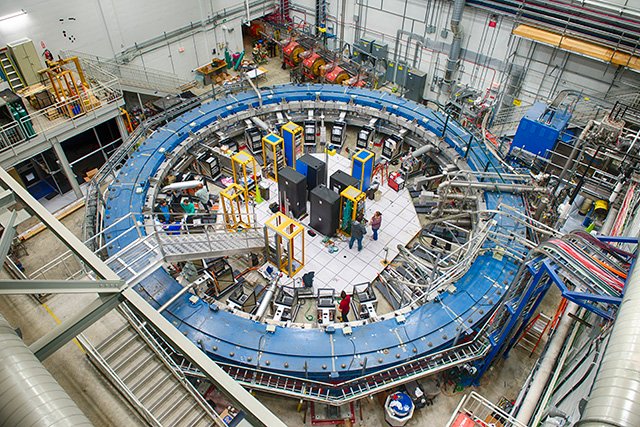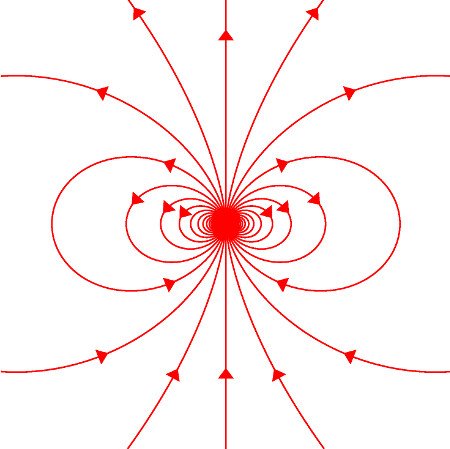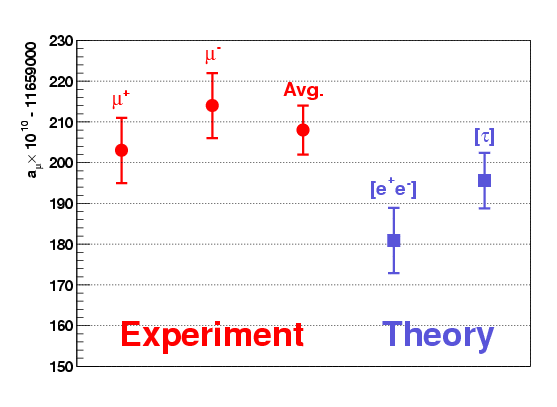Beyond the Standard Model: The Muon g-2 Experiment

The storage ring magnet. [Image credits - Glukicov on Wikipedia]
On May 31st 2017 the latest cycle of a long running experiment was initiated in the MC-1 building of Fermilab which would collect data for the next three years.
This experiment started over 18 years ago and is aimed at measuring with an extremely high degree of precision the anomalous magnetic moment of the muon.
Muons
The muon is one of the 12 fermions described by the Standard Model.
A cousin of the electron, the muon has an identical electric charge and spin but is 200 times more massive.
The muon is unstable and decays, mostly into an electron and two different types of neutrinos, with an average mean lifetime of 2.2μs. This is rather slow in the world of particle physics.
One of the side effects of the muon's large mass is that it can run much deeper into matter than the electron. For example, muons originating from cosmic rays can be measured in deep mines.
 [Image credits - [Bdushaw](https://commons.wikimedia.org/w/index.php?title=User:Bdushaw&action=edit&redlink=1) on Wikipedia]
[Image credits - [Bdushaw](https://commons.wikimedia.org/w/index.php?title=User:Bdushaw&action=edit&redlink=1) on Wikipedia]
Like the electron, the muon can be seen as an infinitesimally small gyrating electric charge, acting like a small magnet spinning around itself. This causes the muon to generate a magnetic field around itself.
Anomalous Magnetic Moment of the Muon
When placed into a magnetic field, the muon wants to align itself with the field but its angular momentum prevents this from happening. This causes a torque force from the magnetic field to be applied on the muon causing its spinning axis to rotate, or precess, around its magnetic axis.
The strength of this elementary little magnet is called the magnetic moment and its theoretical value is predicted by Dirac equation in g-factor units.
Excluding any other factor, Dirac equation predicts g=2. However we now understand that the quantum fluctuations of the vaccuum result in virtual particles disrupting this value.
This divergence from the ideal value g=2 is predicted by the Standard Model and is referred to as the anomalous magnetic moment.

The original observed g-2 value of various particles, released in 2004.
[Image credits - The E821 Muon (g-2) Home Page]
The Muon g-2 Experiment
The experiment that is taking place in Fermilab is aimed at measuring the muon g-2 value with a precision of 140 parts per billion, equivalent to measuring the length of a football field with a precision of one thenth the thickness of a human hair.
The objective of the experiment is to compare the measured value of the g-2 value to the one predicted by the Standard Model.
This is important because the first experiments that were conducted in the late 1990's and early 2000's measured a g-2 value that was significantly different than the standard model's predicted value.
Should this discrepancy persists with the new and four times more precise experiment, it could indicate a truly new discovery not explained by the current Standard Model.
Such discovery could point at other emerging theories such as Supersymmetry, or dark photons that could be part of the hypothetical Dark Matter in the universe.
The muon is chosen over the electron to measure the anomalous magnetic moment because it is heavier and makes it more sensitive to new types of virtual particles.
The particle accelerator in Fermilab can accelerate a large quantity of muons at a speed close to the speed of light, causing the muon to remain stable for about 64 microseconds due to relativistic time dilatation.
The Laboratory Setup
The Experiment involves reusing the particle accelerator in Fermilab along with the incredibly powerful and precise electromagnet that was used in the original experimentation, over 20 years ago.

[Image credits The E821 Muon (g-2) Home Page]
Every 12 seconds a large number of protons (1012) are collided at relativistic speed against a fixed target which result in many types of particles being created.
The particles that are of interest are the pions, each one consisting of a quark and an anti-quark.
These pions quickly decay into muons with spins pointing in the same direction.
Powerful magnets direct these muons through a triangular tunnel, named Muon Delivery Ring.
The muons are then delivered into the 50 foot electromagnet previously mentioned.
Under the magnetic field influence of the electromagnet, the muons exhibit the precession phenomenon described previously.
The muons then decay into positrons and neutrinos.
The neutrinos are weakly interacting and are not detected, however the positrons can be measured. These positrons have kept the same angular momentum as the original muons (same spinning axis angle) and their precession can be measured with a high level of accuracy by specifically designed detectors.
Outcome of the Experiment
The experiment is expected to run until 2020 upon which researchers will be able to provide a very accurate figure for the muon g-2 value.
This value will then be compared to the value predicted by the Standard model.
If it diverges by over a specific threshold (sigma) it could yield to new physic theories or corroborate emerging ones.
This post has been voted on by the steemstem curation team and voting trail.
There is more to SteemSTEM than just writing posts, check here for some more tips on being a community member. You can also join our discord here to get to know the rest of the community!
For the fun, I am just dropping this link, a post I wrote about a year ago ;)
I have nothing special to say here. Nice post :)
Hi, and thanks for the link to your post. It's nice to read it now that I have some background knowledge about the subject.
It will be interesting to learn the results from the scientists in Fermilab in a couple of years.
Who know, maybe the LHC will have turned up some new discovery by then that might explain the g-2 measurements.
Cheers.
This is what we all hope. But nature likes having fun with us :D
Hi. Thanks for a well writing post. Not a particle physics enthusiasts but I guess I was able to learn a new thing here, and that's...
Never thought there is in existence another compound that can decompose to produce electron in the manner described here.
@sciencetech from STEM
Thanks a lot. Glad you enjoyed the post.
Congratulations @irelandscape! You have completed the following achievement on Steemit and have been rewarded with new badge(s) :
Click on the badge to view your Board of Honor.
If you no longer want to receive notifications, reply to this comment with the word
STOPDo not miss the last post from @steemitboard:
SteemitBoard World Cup Contest - The results, the winners and the prizes